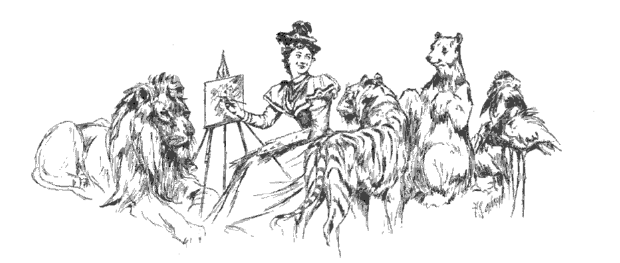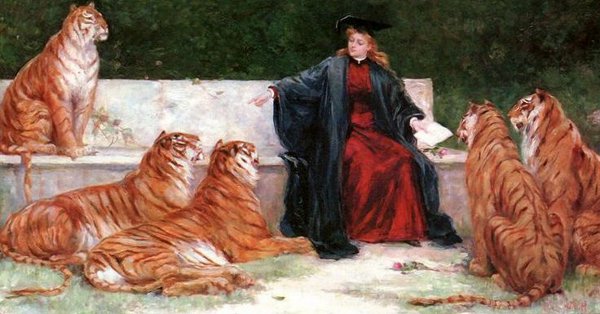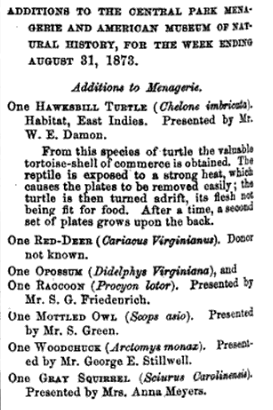The Artist, the Lady and the Tiger
In my reading about the zoo, I learned about the American painter Frederick Stuart Church, who regularly used the animals of the zoo as models. It seems he was quite fond of depicting young ladies in company with big cats. He wrote a rambling illustrated article about his work and experiences for Scribner’s Magazine in December 1893, Vol. XIV, No. 6, which I found entertaining and intriguing.
Excerpts from “An Artist Among Animals,” written and illustrated by F.S. Church

I saw a young girl in the lion-house at the Central Park Zoo modeling a tiger. One morning I watched her for some time, and after she got through her work and was about to go, she took a rose from her dress and threw it into the animal. You know some of the cat family are very susceptible to the different odors, and the action of that tiger must have astonished the young girl. There was every expression of animal gladness in the way that he fondled and caressed the flower. I suggested to the young lady that it might be perfectly safe for her to go in the cage, the tiger seemed in such an amiable mood. She seemed half inclined to act on my suggestion and go in, but perhaps it was just as well she didn’t. You can never trust them.
After reading the first bit, which had come up on my search for “Central Park Zoo,” I assumed, as you may have up to this point, that this was a piece about the practice of drawing and sketching live animals, and maybe the exotic options available at the zoo. But Church, as a working artist, took commissions and therefore shares this anecdote.
I have a sketch on my wall–a rough cartoon of a tigress creeping up through the jungle with a most wicked glare in her eye, as if about to spring on a very pretty young woman in diaphanous drapery, who is seated on a bank with her feet in the water, apparently dreaming over a lapful of lotus flowers. That picture was suggested, and an order given to paint it, by a young New England girl, who is, or thought she was, a “reincarnationist.” She was one of the finest specimens of New England beauties I have ever seen, from the best old Puritan and Hugenot stock, her father, a magnificent specimen of manhood, following in the faith of his fathers; but she, in a future state, expected or hoped to take the form of a tigress, and go around eating up good-looking young girls. Queer idea, wasn’t it, and she had such a sweet and sympathetic disposition?
I took the order, but do you know I was never able to make that animal take the fatal leap. With a great of persuasion I induced Mr. Conklin, the former careful and thoroughly experienced superintendent at the Central Park Zoo, to allow a tiger to be enraged up to a most desperate point, by having a young bear cub placed dangerously near his cage, and I made lots of studies in movement and expression of that animal’s most ferocious efforts to get at that cub, but it was of no use. I then changed the whole idea, and made a recumbent tigress looking up with a most placid expression into the face of the young woman, who still continued to dream over the lilies. The “reincarnationist” was disgusted, and I sold my “idyl” at a quarter of the price to “another fellow.” That change of expression cost me $750, and should have taught me a lesson, which some of my realistic friends would say served me right.”
Wait, what?
First, what about this New Englander of good Puritan and Hugenot stock casually appropriating ideas of reincarnation????
Second, she sounds like some kind of badass wanting to be reincarnated as a lady-eating tiger.
Third, that was an amazing character sketch of both the lady and the artist.
You can see that I really had to share once I read that bit. There’s more. Church wasn’t just about the drawing of ladies with animals. Apparently he was also about allegory.

One of my female critics, who is not in sympathy with my work, was looking the other day at a picture of mine which I call “Knowledge is Power.” It represents a young girl in college gown reading to a lot of tigers. The lady said: “If anyone needs knowledge that girl does, or she wouldn’t be such a stupid fool as to sit among a lot of tigers.” An excellent criticism from her stand-point, but perhaps it is not what I am getting at.
Okay, Church, you don’t understand the feelings of the “reincarnationist” and your female friends may not understand your philosophy either. I guess it’s a draw? At least you can idealize the nature of the female cats.
I paint the lioness much more than I do the lion. Probably few notice the difference, but I use the tigress in all my pictures in preference to the male. There is something in the female of the cat species, particularly, that appeals to much more than the male. She has certain lines, movements, alertness and quickness of perception, with a sort of you-had-better-look-out expression, which I don’t see in the male. I often think of that tigress I read of in a report of the London Zoo, who, accompanied by her two cubs, stealthily approached in the middle of the night a small temporary board shanty, where some native East Indian railroad workmen were sleeping. Leaving her cubs at the door, she stole in, grabbed one of the sleeping men, and made off with him before the horrified occupants could realize the situation.
Just think the peculiar intelligence shown not only in her successful raid, but in her instructions to her cubs, who she made wait outside for her while she did her terrible work!
This bit put me in mind of Kipling’s 1911 poem The Female of the Species, which concludes most stanzas with “The female of the species is more deadly than the male” and posits that females are fierce because they have an unshakeable instinct to protect their young, while males can be logical. For a reply to that, I recommend Charlotte Anna Perkins Gilman’s reply More Females of the Species.
But the poetry is a tangent away from F.S. Church. My imagination is particularly fired, not by his ideas about the females of the species, or by the allegorical meanings of the women he painted, but by the women he describes interacting with: the female painter, the critic, and, of course, the “reincarnationist.”
I had been thinking to make one of my heroines involved in spiritualism or vaudeville in some way, and the idea of a young lady of New England who wishes she were a tigress seems like it could play into that beautifully. There is something there about women looking for more expansive role in society and not wanting to be confined by the feminine ideals of the time. Why be the allegorical beauty reading to the tigers when you could be the tiger? Her explicit desire is to be a tigress who will “go around eating up good-looking young girls”! She seems ready to completely destroy and discard the current female role. Definitely a suffragist. Perhaps ready to smash the patriarchy as well. I’ll just have to be careful that she doesn’t cross over into Spirit Weavers Gathering territory…
You can see more examples of Church’s work on the Wikimedia Commons, as well as on artnet.com and americangallery19th.wordpress.com. In addition to ladies and big cats, he also painted ladies with polar bears or flamingos, or even by themselves without animal companions.
